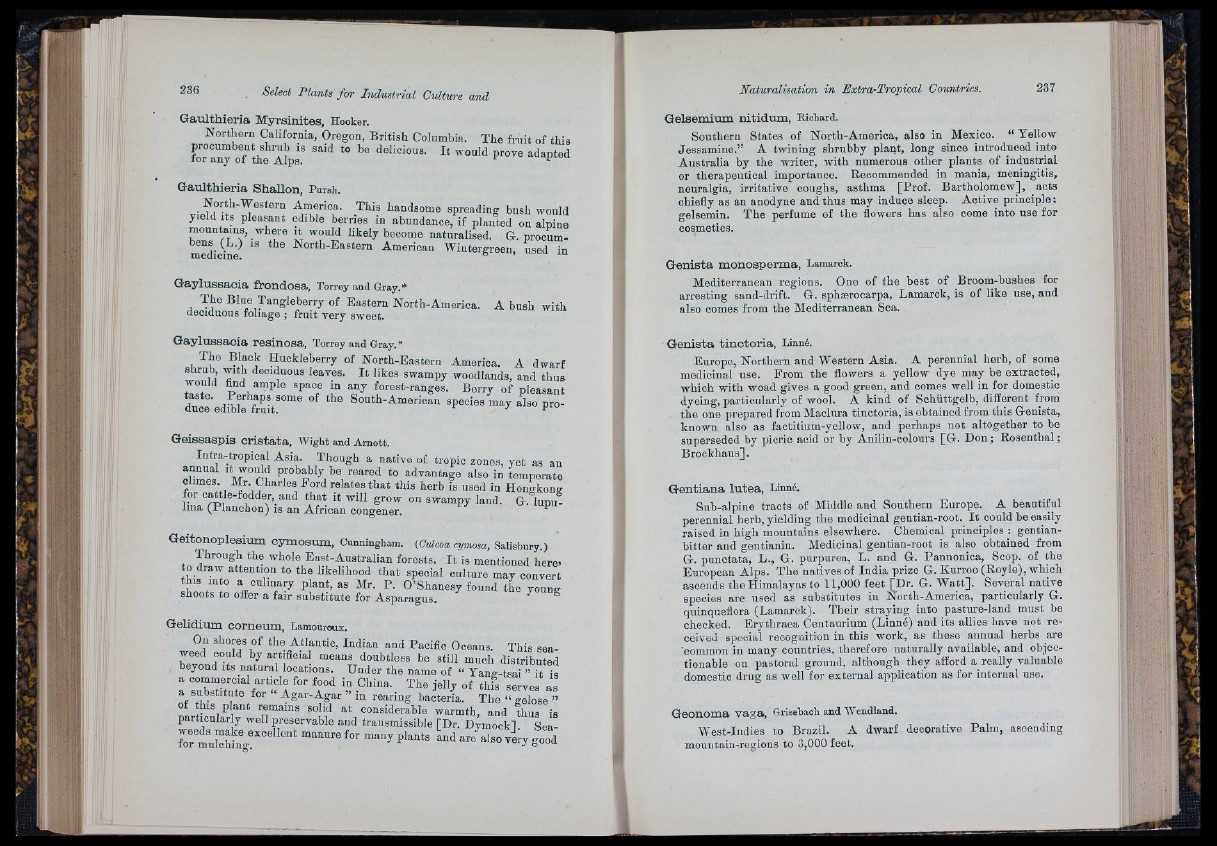
1
; l:|i ' !
Gaulthieria Myrsinites, Hooker.
Northern California, Oregon, British Columbia. The fruit of this
C 2 n 7 oTihe Ifp s"
Gaulthieria Shallon, Pursh.
handsome spreading bush would
yield Its pleasant edible berries in abundance, if planted on alpine
naturalised. G. procum-
m 2 ic !n e North-Eastern American Wintergreeu, used in
Gaylussacia frondosa, Torrey and Gray.*
The Blue Tangleberry of Eastern North-America. A bush with
deciduous foliage ; fruit very sweet.
Gaylussacia resinosa, Torrey and Gray.*
The Black Huckleberry of North-Eastern America. A dwarf
wofod T n J IJke® woodlands, and th u s
would find ample space in any forest-ranges. Berry of pleasant
r : - e d f b f f r t ! ““ '’ South-Amencan species L y a^iso pr!-‘
Geissaspis cristata, Wight and Arnott.
Intra-tropical Asia. Though a native of tropic zones, yet as an
e l im IvT ^ L k be reared to advantage also in temperate
climes. Mr. Charles Ford relates th a t this herb is used in Hongkong
for cattle-fodder,_and th a t it will grow on swampy land. G. lupu-
iina (Flancbon) is an African congener.
Geitonoplesium cymosum, Cunningham. (Oulcoa cymosa, Salisbury.)
Through the whole East-Australian forests. I t is mentioned here>
to draw attention to the likelihood th a t special culture may convert
i n / “ ° L®“ O’Sbanesy shoots to offer a fair substitute for Asparagus. found the young
Gelidium corneum, Lamouraux.
On shores o f the Atlantic, Indian and Pacific Oceans. This seaweed
coMd by artificial means doubtless be still much distributed
beyond its natural locations. Under the name of “ Yang-tsai ” it ia
a commercial article for food in China. The jelly of this serves as
a substitute for “ Agar-Agar ” in rearing bacteria. The “ gelose ”
ot tins plant remains solid a t considerable warmth, and thus is
particularly well preservable and transmissible [Dr. Dymock]. Sea-
Tor m u k S g® ^ “ g°°d
Gelsemium nitidum, Eiohard.
Southern States of North-America, also in Mexico. “ Yellow
Jessamine.” A twining shrubby plant, long since introduced into
Australia by the writer, with numerous other plants of industrial
or therapeutical importance. Recommended in mania, meningitis,
neuralgia, irritative coughs, asthma [Prof. Bartholomew], acts
chiefly as an anodyne and thus may induce sleep. Active principle :
gelsemin. The perfume of the flowers has also come into use for
cosmetics.
Genista monosperma, Lamarck.
Mediterranean regions. One of the best of Broom-bushes for
arresting sand-drift. G. sphærocarpa, Lamarck, is of like use, and
also comes from the Mediterranean Sea.
Genista tinctoria, Linné.
Europe, Northern and Western Asia. A perennial herb, of some
medicinal use. From the flowers a yellow dye may he extracted,
which with woad gives a good green, and comes well in for domestic
dyeing, partioularly of wool. A kind of Sohiittgelb, different from
the one prepared from Madura tinctoria, is obtained from this Genista,
known also as factitium-yellow, and perhaps not altogether to be
superseded by picric acid or by Anilin-colours [G. Don ; Rosenthal ;
Brockhaus].
Gentiana lutea, Linné.
Sub-alpine tracts of Middle and Southern Europe. A beautiful
perennial herb, yielding the medicinal gentian-root. I t could be easily
r a i s e d in high mountains elsewhere. Chemical principles : gentian-
bitter and gentianin. Medicinal gentian-root is also obtained from
G. punctata, L., G. purpurea, L. and G. Pannonica, Scop, of the
European Alps. The natives of India prize G. Kurroo (Royle), which
ascends the Himalayas to 11,000 feet [Dr. G. W a tt]. Several native
species are used as substitutes in North-America, particularly G.
quinqueflora (Lamarck). Their straying into pasture-land must be
checked. Erythraea Centaurium (Linné) and its allies have not re ceived
special recognition in this work, as these annual herbs are
'common in many countries, therefore naturally available, and objectionable
on pastoral ground, although they afford a really valuable
domestic drug as well for external application as for internal use.
Geonoma 'V'aga, Grisebach and Wendland.
West-Indies to Brazil. A dw'arf decorative Palm, ascending
mouiitain-regions to 3,000 feet.